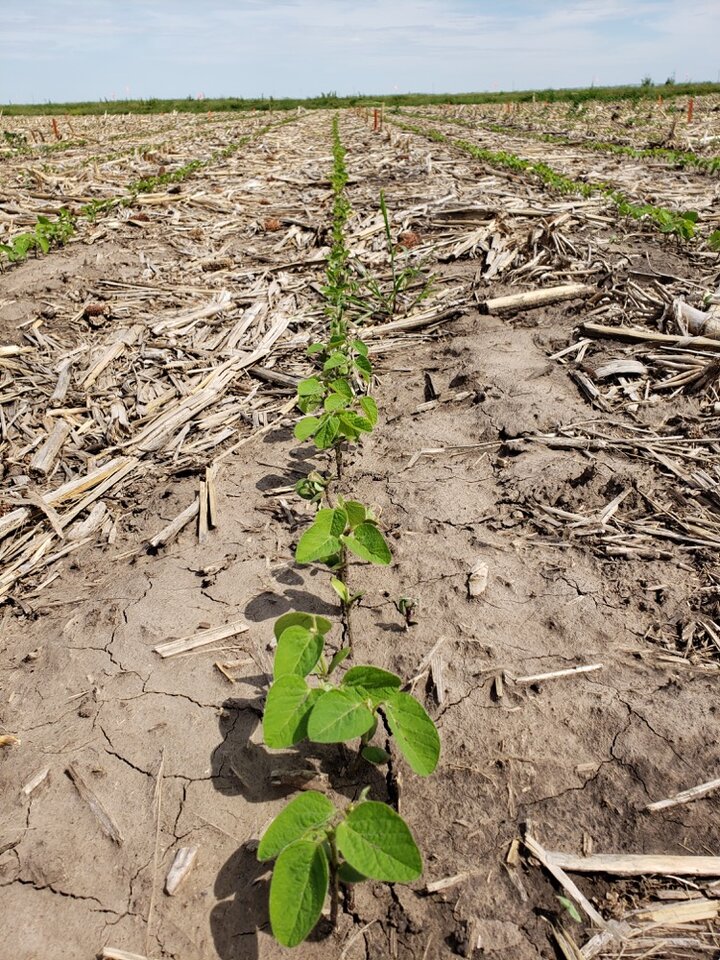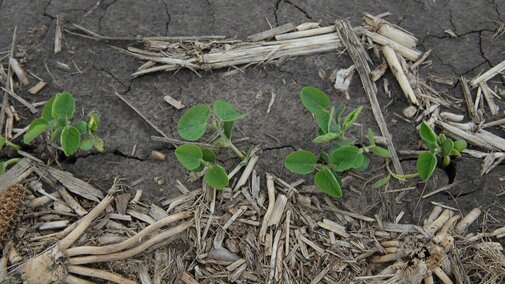Soybean planting was early this year in Nebraska, but dry soil conditions in most of May resulted in poor activation of pre-emergence herbicides applied in rain-fed fields and subsequently less than expected weed control (Figure 1). The cool weather and wet soil conditions in last week of May have disrupted the normal sequence of early season field operations such as herbicide applications. Early season weed control is imperative to maximize soybean yield. PPO-inhibiting herbicides have to be applied before soybean emergence, therefore they cannot be applied now as a majority of soybeans have emerged in south-central Nebraska (Figure 2 and 3). A few residual herbicides such as Anthem Maxx, Dual II Magnum, FirstRate, Outlook, Prefix, Pursuit, Warrant, Warrant Ultra and Zidua can be applied after soybean emergence. Some of these herbicides such as FirstRate (only for broadleaf weeds), Pursuit, Prefix and Warrant Ultra have foliar activity to control small, emerged weeds.



Given most soybeans grown in Nebraska are glyphosate-resistant, glyphosate can be tank-mixed with residual herbicides with no foliar activity such as Dual II Magnum, Warrant or Zidua to control weeds already emerged at the time of application. Six weeds have evolved resistance to glyphosate, so glyphosate will not be effective for their control. Tank-mix other soybean post-emergence herbicides to control emerged weeds. This would add a different site of action and might effectively control glyphosate-resistant weeds. Tank-mix partners may cause other effects regardless of the application timing. Follow application timing and other restrictions of tank-mix herbicide partners as noted on the herbicide labels.
Treatment Guide
There are several factors to consider when addressing weed control with residual herbicides applied after soybean emergence:
- Soybean growth stage.
- Tank mix partner.
- Weed height (for tank-mixing residual herbicide with foliar active herbicide).
- Adjuvants.
The following is specific information for residual herbicides that can be applied after soybean emergence:
Anthem MAXX is a premix of fluthiacet-methyl (Cadet) and pyroxasulfone (Zidua). Cadet is very effective for control of existing velvetleaf, but not labeled for waterhemp and Palmer amaranth control; therefore, this herbicide pre-mix will not control existing pigweeds. Pyroxasulfone (Zidua) in Anthem Maxx will provide residual control of pigweeds and other weeds. Anthem MAXX can be applied up to the sixth trifoliate soybean leaf stage.
Dual II Magnum can be applied at a rate of 1 to 1.33 pints per acre as a post-emergence treatment to soybeans from emergence up through the third trifoliate leaf stage. Dual II Magnum will not control emerged weeds so it must be applied to a weed-free soil surface or in a tank mixture with products that provide post-emergence control of weeds present at the time of application. Do NOT apply Dual II Magnum if S-metolachlor products such as Dual Magnum or Dual II Magnum have already been applied.
FirstRate may be applied any time prior to the 50% flowering stage of soybeans. Application prior to full emergence of the first soybean trifoliate leaf may cause temporary yellowing or chlorosis. Tank-mix partners may cause other effects regardless of application timing.
Pursuit can be applied early post-emergence in soybean when weeds are actively growing and before they exceed a height of 3 inches. Apply Pursuit before soybean bloom at an application rate of 4 oz per acre. Base application timing on weed size and not crop growth stage. Do NOT tank-mix Pursuit with clomazone-containing herbicides such as Command. Use a crop oil concentrate at 1.25 gallon per 100 gallon of spray solution.
Prefix can be applied at 2 to 2.33 pints per acre as a post-emergence application from cracking through the third trifoliate stage of soybeans. Necrotic spotting, leaf crinkling or curling of soybean leaves may occur following post-emergence application, but soybean soon outgrow these effects and develop normally. Prefix alone may control or partially control some emerged broadleaf weeds; however, for broad spectrum control, tank-mix with other herbicides. Add non-ionic surfactant at 0.25% v/v to the final spray volume. Do NOT use crop oil concentrate when applying Prefix post-emergence as these spray adjuvants may increase soybean injury.
Outlook is a selective residual herbicide for controlling annual broadleaf AND grass weeds. Emerged weeds will not be controlled and must be controlled with an appropriate post-emergence herbicide. Outlook can be applied from emergence to fifth trifoliate soybean leaf stage. The application rates in a single application are 12 to 18 fl oz per acre on coarse-texture soils and 14 to 21 fl oz per acre on medium-texture or fine-texture soils. This can also be influenced by soil organic matter content. If Outlook is applied in two split applications, maintain a minimum 14 day-interval between applications and do NOT exceed a seasonal total of 24 fl oz per acre.
Warrant is an acetochlor-based residual herbicide that can be applied post-emergence in soybean after soybeans are completely emerged, but before they reach R2 (initiation of flowering) growth stage. It can be applied at 1.25 to 2 quarts per acre, depending on soil texture and organic matter content. The optimum timing and rate of application is when soybeans are V2 to V3 stage at 1.5 quarts per acre. Warrant is a residual herbicide, so it must be tank-mixed with a foliar active herbicide to control existing weeds.
Warrant Ultra is a premix of acetochlor (Warrant) and fomesafen (Flexstar). In Nebraska, Warrant Ultra can be applied only in counties east of or intersected by U.S. Highway 281) Fomesafen has foliar activity; therefore, it can provide control of existing weeds if they are less than four inches tall. It is a contact herbicide, so enough coverage is needed. Acetochlor (Warrant) will provide residual control of number of weeds. Warrant Ultra can be applied up to R2 (full flowering) soybean growth stage.
Zidua SC is a liquid formulation of Zidua. It is a selective residual herbicide for control of annual grasses, broadleaf and sedge weeds. It can be applied to soybean from pre-plant to sixth trifoliate leaf stage. The post-emergence application rate is in a range of 2 to 3.5 fl oz per acre, depending on soil texture. Zidua has no foliar activity, so it must be mixed with foliar active herbicide for control of existing weeds depending on soybean trait planted.

